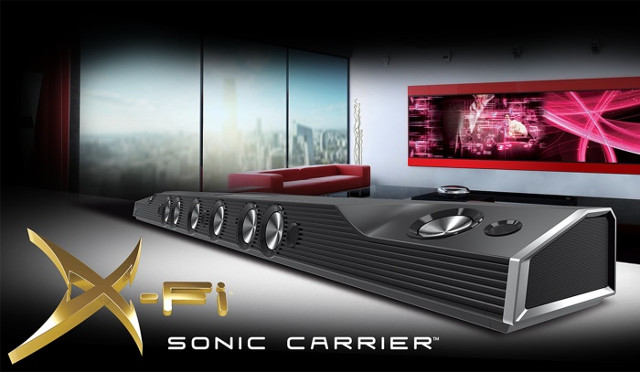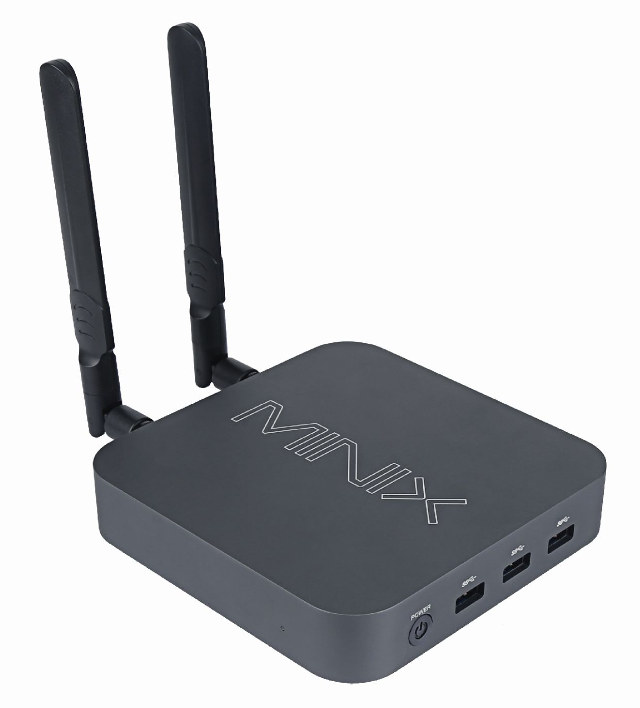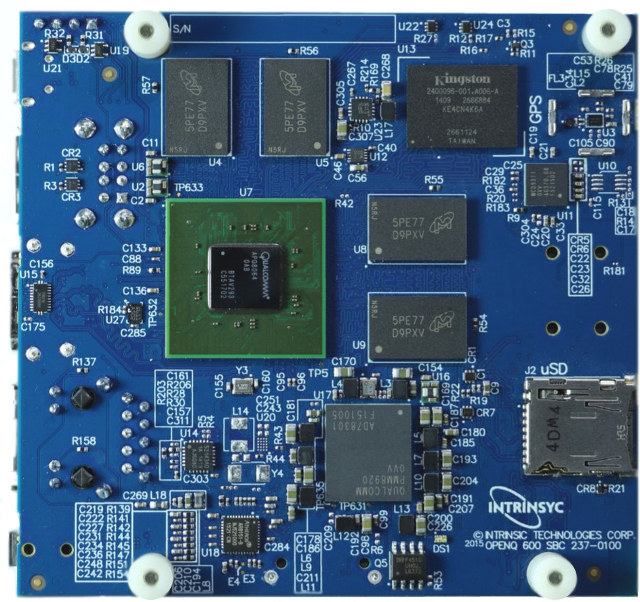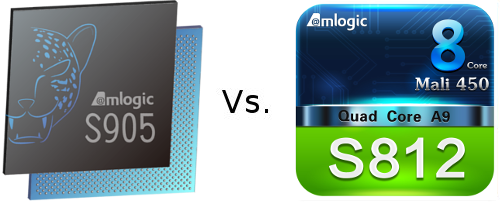Android started as a mobile operating system for smartphones, but over the years we’ve seen it being used in tablets, mini PCs, cars, printers, wearables, and many other product categories. Creative X-Fi Sonic is a “speaker system” with video outputs that runs Android, in a similar way to Xiaomi TV bar, but with much higher capabilities. X-Fi sonic carrier key features and specifications: 7 processors with 14 cores 15.2 high-resolution audio system in a 11.2.4 (front.sub.height) speaker configuration with Dolby Atmos technology. Creative EAX 15.2 Dimensional Audio processing algorithms 800 watts RMS total system power. Video playback engine supporting 4K (60fps) Video I/O – 1x HDMI 2.0a output, 3x HDMI 2.0a inputs Audio Inputs – 2x analog inputs, 2x digital optical inputs, 2x microphone inputs Streaming protocols – AirPlay and Google Cast for audio, Miracast, Chromecast, and DLNA. Connectivity – Gigabit Ethernet, 802.11 b/g/n/ac Wi-Fi, Bluetooth, and a zero-latency speaker-to-speaker […]
BayLibre ACME Cape for BeagleBone Black Measures Power and Temperature with Sigrok
Sigrok open source signal analysis software suite had a major release last week-end with libsigrok 0.4.0, libsigrokdecode 0.4.0, sigrok-cli 0.6.0, and PulseView 0.3.0. The new version added numerous bug fixes for supported hardware such as UNI-T UT61E digital multimeter or USBee AX Pro logic analyzer, and added support for several logic analyzers, oscilloscopes, multimeters, programmable power supplies, an electronic load, an LCR meter, a scale, and one BeagleBone Black cape, namely BayLibre ACME. The ACME initiative was launched in order to get rid of the limitations of proprietary solutions, and provide an open source hardware and software multi-channel power and temperature measurements solution to the community. BayLibre ACME cape supports up to 8 probes to measure VBUS (0 to +36V), VSHUNT ( 2.5uV up to 81.92mV), CURRENT AND POWER. Three current / power probes have been developed with all featuring TI INA226 for the ADC conversion: ACME HE10 Power Probe […]
NayuOS is a Developer Friendly Chromium OS Fork without Google Services
People at Nexedi, an European based open-source software publisher, are doing a lot of development work on Chromebooks, but with Chrome OS, all your data is kept on Google servers when you login, and by default the OS basically runs Chrome browser with barely any development tools. So the company leveraged Chromium OS, the open source version of Chrome OS, to create their own operating system, called NayuOS, that does not run any proprietary software, does without Google servers, and comes with git, nmp and other developer tools by default. The operating system should also provide a better Chromebook experience in China, thanks to the company’s re6stnet app and GrandeNet system allowing to have IPv6 available even when ISPs only provide IPv4, and to work around the unreliable Internet infrastructure in China. The source code and instructions to build an image yourself are available, but the company also released binary […]
MINIX NGC-1 Braswell Mini PC Runs Windows 10 or Ubuntu
MINIX showcased some unnamed Braswell mini PCs at IFA 2015 last September, but since then the company has been pretty quiet about their new Intel based mini PCs. The good news is that MINIX NGC-1 will be launched in about two weeks with an Intel Celeron N3150 quad core “Braswell” processor coupled with 4GB RAM, and 128GB M.2 SSD, and beside running Windows 10 64-bit, it will also support Ubuntu. MINIX NGC-1 specifications: SoC – Intel Celeron N3150 quad-core processor @ 1.6 GHz / 2.08 GHz (Turbo) with 2MB L2 cache, and Intel HD graphics with 12EU (4W SDP / 6W TDP) System Memory – 4GB DDR3L Storage – 128 M.2 SSD Video Output – HDMI 1.4 up to 4K @ 30 Hz, and mini DisplayPort Audio I/O – HDMI, 3.5mm stereo jack (microphone + headphone), and optical S/PDIF Connectivity – Gigabit Ethernet, 802.11ac WiFi and Bluetooth 4.2 with two […]
Mini Review of G9C Android Media Player
Shenzhen Tomato sent me their G9C Android TV box at the beginning of December, but as Google Play was not working reliably in the first firmware, I decided to delay the review a little, and the company has provided a new working firmware a few weeks ago, and I’ve now taken the time to test some the main issues I normally find on Amlogic S905 Android TV box. I’ve also ready shown pictures of the device and the board, so today, I’ll only report my experience with the firmware. First Boot and First Impressions I’ve connected all necessary cables, and several USB devices include an harddrive and RF dongles for MINIX NEO A2 Lite air mouse and Tronsmart Mars G01 gamepad. The device started automatically upon connecting the power, and on average the boot takes between 25 to 30 seconds. Not bad at all for an entry-level device. The launcher […]
Embedded Systems Conference 2016 Schedule – April 13-14
The Embedded Systems Conference 2016 will take place in Boston on April 13-14, and the organizers have now released the schedule, minus some keynotes, which features four main tracks: Embedded Hardware, Embedded Software, Connected Devices and the Internet of Things (IoT), and the ESC Engineering Theatre. As usual, I’ve gone through the list of talks and composed my own little virtual schedule which ended up with sessions focusing on power management, IoT, and security, as well some optimization and drivers development talks among others, such as patents, and the origin of Gerber files. Wednesday 13 8:00 – 9:00 – Power Management in Embedded Systems by Colin Walls, Embedded Software Technologist, Mentor Graphics The importance of power management in today’s embedded designs has been steadily growing as an increasing number of battery powered devices are developed. In this session, we will discuss design considerations that should be made when starting a […]
Intrinsyc Open-Q 600 Single Board Computer is Powered by Qualcomm Snapdragon 600 Processor
Intrinsyc has released several Qualcomm Snapdragon development kits and system-on-modules over the last few years, and the company has now unveiled their first single board computer with Open-Q 600 SBC powered by Snapdragon 600 quad core processor with 2GB RAM and 16GB eMMC flash. Open-Q 600 specifications: SoC – Qualcomm Snapdragon 600 (APQ8064) quad core Krait 300 processor @ 1.7GHz with 2MB L2 cache, Adreno 320 GPU, and Hexagon QDSP6V4 DSP System Memory – 2GB PCDDR3 RAM @ 533MHz; dual channel 32-bit Storage – 16GB eMMC 4.5 flash, micro SD card slot Video Output / Display I/F – HDMI 1.4a port for up to 1080p @ 60Hz, 2-lane MIPI-DSI connector Audio – HDMI, 3.5mm stereo headset output with mono input, 3.5mm Mic line in; Qualcomm WCD9311 audio codec Camera – 2-lane MIPI-CSI connector supporting 8 MP camera up to WXGA resolution @ 60 fps Connectivity Gigabit Ethernet (RJ45) via Qualcomm […]
Amlogic S905 vs S812 Benchmarks Comparison
After seeing benchmarks comparisons between Amlogic S905 and S805, as well as Amlogic S905 vs Rockchip RK3368, several people asked me to compare the older Amlogic S812 32-bit processor to the newer Amlogic S905 64-bit processor, so I’ve gone ahead and compared the results for several benchmarks obtained with WeTek Core and K1 Plus Android 5.1 TV boxes, respectively powered by Amlogic S812 and Amlogic S905. A ratio greater than one means Amlogic S812 is the fastest, and I’ve highlighted the ratio with red or green colors so that red color is a plus for S905, and green color means S812 achieved a better result. Amlogic S905 Amlogic S812 Ratio CPU Quad core Cortex A53 @ 2.02 GHz Quad core Cortex A9 @ 1.99 GHz GPU Penta-core ARM Mali-450MP Octa-core ARM Mali-450MP Antutu 5.x Overall 28,027 33,953 1.21 Multitask 4,260 4,701 1.10 Runtime 2,721 3,383 1.24 RAM Ops 1,960 2,228 […]









